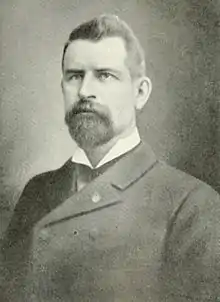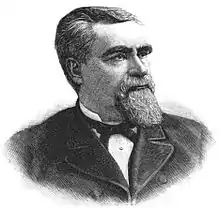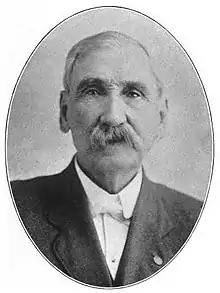South Dakota's at-large congressional district
South Dakota's at-large congressional district is the sole congressional district for the state of South Dakota. Based on area, it is the fourth largest congressional district in the nation.
| South Dakota's at-large congressional district | |||
|---|---|---|---|
 | |||
| Representative |
| ||
| Area | 75,885 sq mi (196,540 km2) | ||
| Distribution |
| ||
| Population (2019) | 884,659[1] | ||
| Median household income | $59,533[2] | ||
| Ethnicity |
| ||
| Cook PVI | R+14[3] | ||
The district is currently represented by Dusty Johnson.
History
The district was created when South Dakota achieved statehood on November 2, 1889, electing two members at-large (statewide). Following the 1910 Census a third seat was gained, with the legislature drawing three separate districts. The third district was eliminated after the 1930 Census.
Following the 1980 Census the second seat was eliminated, creating a single at-large district. Since 1983, South Dakota has retained a single congressional district.
Voter registration
| Voter Registration and Party Enrollment as of January 2, 2013 | |||||
|---|---|---|---|---|---|
| Party | Total Voters | Percentage | |||
| Democratic | 190,212 | 35.77% | |||
| Republican | 244,111 | 45.91% | |||
| Minor Parties | 1,523 | 0.29% | |||
| Unaffiliated | 95,846 | 18.03% | |||
| Total | 531,692 | 100% | |||
Democratic primary
Hillary Clinton of New York won the June 3, 2008 South Dakota Democratic Primary with 55.35% of the statewide/at-large congressional district vote while Barack Obama of Illinois received 44.65%. The state/at-large congressional district gave Clinton her final win during the course of the historic and heavily drawn-out 2008 Democratic Presidential Primary season.
- U.S. Representative Stephanie Herseth Sandlin, who had previously endorsed John Edwards, decided to support Obama before her state/congressional district voted in the primary for Clinton.
Republican primary
John McCain of Arizona easily won the June 3, 2008 South Dakota GOP Primary with 70.19% of the statewide/at-large congressional district vote while libertarian-leaning Ron Paul of Texas finished in second place in the state/congressional district with 16.52%.
Election results from presidential races
| Year | Office | Results |
|---|---|---|
| 2000 | President | Bush 60 - Gore 38% |
| 2004 | President | Bush 60 - Kerry 38% |
| 2008 | President | McCain 53 - Obama 45% |
| 2012 | President | Romney 58 - Obama 40% |
| 2016 | President | Trump 62 - Clinton 32% |
| 2020 | President | Trump 62 - Biden 36% |
Recent elections
2004 special election
Incumbent U.S. Representative Bill Janklow resigned the seat January 20, 2004, after he was convicted of second-degree manslaughter, triggering a special election. Democrat Stephanie Herseth was selected as the Democratic nominee for this special election and she defeated Republican Larry Diedrich with 51 percent of the vote in a close-fought election on June 1, 2004. Herseth's victory briefly gave the state its first all-Democratic congressional delegation since 1937.
2004 general election
In the November general election, Herseth was elected to a full term with 53.4 percent of the vote, an increase of a few percentage points compared with the even closer June special elections. Herseth's vote margin in June was about 3,000 votes, but by November it had grown to over 29,000.
Herseth thereby became the first woman in state history to win a full term in the U.S. Congress.
Both elections were hard-fought and close compared to many House races in the rest of the United States, and the special election was watched closely by a national audience. The general election was also viewed as one of the most competitive in the country, but was overshadowed in the state by the highly competitive U.S. Senate race between Democrat Tom Daschle and Republican John Thune, which Thune narrowly won.
2006 election
| Party | Candidate | Votes | % | ±% | |
|---|---|---|---|---|---|
| Democratic | Stephanie Herseth Sandlin (Incumbent) | 230,468 | 69.09 | +15.73 | |
| Republican | Bruce Whalen | 97,864 | 29.34 | −16.57 | |
| Libertarian | Larry Rudebusch | 5,230 | 1.57 | +0.85 | |
| Democratic hold | Swing | ||||
| Turnout | 333,562 | ||||
2008 election
| Party | Candidate | Votes | % | ±% | |
|---|---|---|---|---|---|
| Democratic | Stephanie Herseth Sandlin (Incumbent) | 256,041 | 67.56 | −1.53 | |
| Republican | Chris Lien | 122,966 | 32.44 | +3.10 | |
| Democratic hold | Swing | ||||
| Turnout | 379,007 | ||||
2010 election
| Party | Candidate | Votes | % | ±% | |
|---|---|---|---|---|---|
| Republican | Kristi Noem | 153,703 | 48.12 | +15.68 | |
| Democratic | Stephanie Herseth Sandlin (Incumbent) | 146,589 | 45.89 | −21.67 | |
| Independent | B. Thomas Marking | 19,134 | 5.99 | +5.99 | |
| Republican gain from Democratic | Swing | ||||
| Turnout | 319,426 | ||||
2012 election
| Party | Candidate | Votes | % | ±% | |
|---|---|---|---|---|---|
| Republican | Kristi Noem (Incumbent) | 207,640 | 57.45 | +9.33 | |
| Democratic | Matt Varilek | 153,789 | 42.55 | −3.34 | |
| Republican hold | Swing | ||||
| Turnout | 361,429 | ||||
2014 election
| Party | Candidate | Votes | % | ±% | |
|---|---|---|---|---|---|
| Republican | Kristi Noem (Incumbent) | 183,834 | 66.50 | +9.05 | |
| Democratic | Corinna Robinson | 92,485 | 33.50 | −9.05 | |
| Republican hold | Swing | ||||
| Turnout | 276,319 | ||||
2016 election
| Party | Candidate | Votes | % | ±% | |
|---|---|---|---|---|---|
| Republican | Kristi Noem (Incumbent) | 237,163 | 64.10 | -2.4 | |
| Democratic | Paula Hawks | 132,810 | 35.90 | +2.4 | |
| Republican hold | Swing | ||||
| Turnout | 369,973 | ||||
2018 election
| Party | Candidate | Votes | % | ±% | |
|---|---|---|---|---|---|
| Republican | Dusty Johnson | 202,446 | 60.30 | -3.8 | |
| Democratic | Tim Bjorkman | 120,816 | 36.00 | +.1 | |
| Republican hold | Swing | ||||
| Turnout | 323,262 | ||||
2020 election
| Party | Candidate | Votes | % | ±% | |
|---|---|---|---|---|---|
| Republican | Dusty Johnson (incumbent) | 321,984 | 80.96% | +20.61% | |
| Libertarian | Randy Luallin | 75,748 | 19.04% | +17.58% | |
| Total votes | 397,732 | 100.0% | |||
| Republican hold | |||||
List of members representing the district
1889–1913: Two then three seats
Two seats were created in 1889.
| Years | Cong ress |
Seat A | Seat B | ||||||
|---|---|---|---|---|---|---|---|---|---|
| Representative | Party | Electoral history | Representative | Party | Electoral history | ||||
| November 2, 1889 – March 3, 1891 |
51st |  John Pickler |
Republican | Elected in 1889. Re-elected in 1890. Re-elected in 1892. Re-elected in 1894. Retired. |
 Oscar S. Gifford |
Republican | Elected in 1889. Lost renomination. | ||
| March 4, 1891 – August 14, 1891 |
52nd |  John Rankin Gamble |
Republican | Elected in 1890. Died. | |||||
| August 14, 1891 – December 7, 1891 |
Vacant | ||||||||
| December 7, 1891 – March 3, 1893 |
 John L. Jolley |
Republican | Elected to finish Gamble's term. Retired. | ||||||
| March 4, 1893 – March 3, 1895 |
53rd |  William V. Lucas |
Republican | Elected in 1892. Lost renomination. | |||||
| March 4, 1895 – March 3, 1897 |
54th |  Robert J. Gamble |
Republican | Elected in 1894. Lost re-election. | |||||
| March 4, 1897 – March 3, 1899 |
55th | .jpg.webp) John Edward Kelley |
Populist | Elected in 1896. Lost re-election. |
.jpg.webp) Freeman Knowles |
Populist | Elected in 1896. Lost re-election. | ||
| March 4, 1899 – March 3, 1901 |
56th |  Charles H. Burke |
Republican | Elected in 1898. Re-elected in 1900. Re-elected in 1902. Re-elected in 1904. Lost renomination. |
 Robert J. Gamble |
Republican | Elected in 1898. Retired to run for U.S. Senator. | ||
| March 4, 1901 – March 3, 1907 |
57th 58th 59th |
 Eben Martin |
Republican | Elected in 1900. Re-elected in 1902. Re-elected in 1904. Retired to run for U.S. Senator. | |||||
| March 4, 1907 – June 26, 1908 |
60th | .jpg.webp) Philo Hall |
Republican | Elected in 1906. Lost renomination. |
.jpg.webp) William H. Parker |
Republican | Elected in 1906. Died. | ||
| June 26, 1908 – November 3, 1908 |
Vacant | ||||||||
| November 3, 1908 – March 3, 1909 |
 Eben Martin |
Republican | Elected to finish Parker's term. Also elected to next full term. Re-elected in 1910. Redistricted to the 3rd district. | ||||||
| March 4, 1909 – March 3, 1913 |
61st 62nd |
 Charles H. Burke |
Republican | Elected in 1908. Re-elected in 1910. Redistricted to the 1st district. | |||||
In 1913, the two at-large seats were replaced by three districts. There were no at-large seats, therefore, until 1983.
1983–present: One seat
By 1983, the remaining two district seats were reduced to one at-large seat.
References
- Bureau, Center for New Media & Promotion (CNMP), US Census. "My Congressional District". census.gov. Retrieved 24 May 2020.
- https://www.census.gov/mycd/?st=46
- "Partisan Voting Index – Districts of the 115th Congress" (PDF). The Cook Political Report. April 7, 2017. Retrieved April 7, 2017.
- "General Election - November 3, 2020" (PDF). Secretary of State of South Dakota. November 10, 2020. Retrieved November 12, 2020.
- Martis, Kenneth C. (1989). The Historical Atlas of Political Parties in the United States Congress. New York: Macmillan Publishing Company.
- Martis, Kenneth C. (1982). The Historical Atlas of United States Congressional Districts. New York: Macmillan Publishing Company.
- Congressional Biographical Directory of the United States 1774–present



.jpg.webp)


